Youngstown Bank Case Study: Analyzing Financial Risk & Interrelation
VerifiedAdded on 2022/08/13
|10
|2293
|25
Case Study
AI Summary
This case study examines the Youngstown Bank's challenges related to its stock price performance and weak growth compared to peer banks. It focuses on the interrelationships among credit risk, interest rate risk, and liquidity risk, analyzing the bank's balance sheet, market-to-book ratio, and loan commitment prices. The study identifies that the bank's outstanding loan commitments contribute significantly to its default risk, impacting investor confidence and stock valuation. Recommendations include reducing future loan commitments to restore investor faith and positively influence the bank's stock price. The analysis underscores the importance of comprehensive risk management models that consider the interconnectedness of various risk factors for maintaining financial stability and achieving shareholder wealth maximization. Desklib provides access to similar case studies and solved assignments for students.
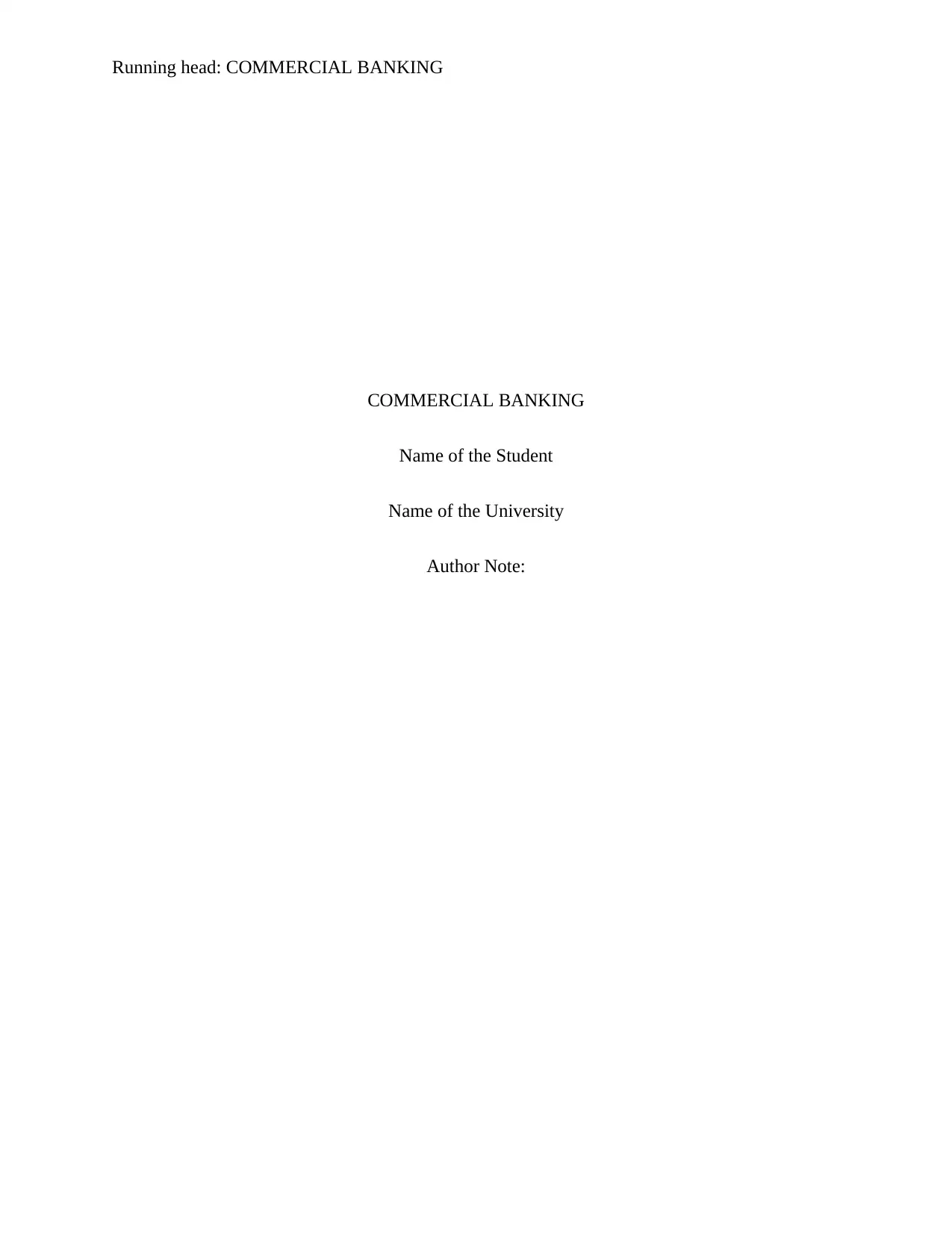
Running head: COMMERCIAL BANKING
COMMERCIAL BANKING
Name of the Student
Name of the University
Author Note:
COMMERCIAL BANKING
Name of the Student
Name of the University
Author Note:
Paraphrase This Document
Need a fresh take? Get an instant paraphrase of this document with our AI Paraphraser

1COMMERCIAL BANKING
Executive Summary
The financial institution faces several types of risk that are unique and specific to the nature of
the industry. This paper focuses on the risk that business faces and the interrelationship among
the different sources of business risk exposure. For the purpose of this paper credit risk, interest
risk and liquidity risk are focused. The given report focuses on the Youngstown bank that is
trying to solve issues related to low stock price and its weak growth in recent years when
compared to other similar banks. The CEO and CFO of the Youngstown bank have been figuring
the cause of low stock price even while the performance of the bank is comparatively better with
other similar-sized banks on an average. A comparison of the results of the bank in the past five
years also shows the growth that the bank has achieved through the help of John Standard
(CEO). The risk has been concluded after a proper scrutiny of the balance sheet shown in Exhibit
B, Market to Book ratio from Exhibit A, Various Industry Ratios from Exhibit C and D and the
Loan Commitment prices from Exhibit E. This risk is interrelated and separately influence the
financial stability of the bank. The recommendation provided will help the managers to
understand and provide a regulatory effort to change the default risk which can indirectly impact
on the credit risk and interest risk of the bank.
Executive Summary
The financial institution faces several types of risk that are unique and specific to the nature of
the industry. This paper focuses on the risk that business faces and the interrelationship among
the different sources of business risk exposure. For the purpose of this paper credit risk, interest
risk and liquidity risk are focused. The given report focuses on the Youngstown bank that is
trying to solve issues related to low stock price and its weak growth in recent years when
compared to other similar banks. The CEO and CFO of the Youngstown bank have been figuring
the cause of low stock price even while the performance of the bank is comparatively better with
other similar-sized banks on an average. A comparison of the results of the bank in the past five
years also shows the growth that the bank has achieved through the help of John Standard
(CEO). The risk has been concluded after a proper scrutiny of the balance sheet shown in Exhibit
B, Market to Book ratio from Exhibit A, Various Industry Ratios from Exhibit C and D and the
Loan Commitment prices from Exhibit E. This risk is interrelated and separately influence the
financial stability of the bank. The recommendation provided will help the managers to
understand and provide a regulatory effort to change the default risk which can indirectly impact
on the credit risk and interest risk of the bank.

2COMMERCIAL BANKING
Table of Contents
Introduction......................................................................................................................................3
Discussion........................................................................................................................................3
Interrelationship...............................................................................................................................4
Type of risk bank is facing..............................................................................................................5
Recommendation.............................................................................................................................7
Conclusion.......................................................................................................................................7
Reference.........................................................................................................................................8
Table of Contents
Introduction......................................................................................................................................3
Discussion........................................................................................................................................3
Interrelationship...............................................................................................................................4
Type of risk bank is facing..............................................................................................................5
Recommendation.............................................................................................................................7
Conclusion.......................................................................................................................................7
Reference.........................................................................................................................................8
⊘ This is a preview!⊘
Do you want full access?
Subscribe today to unlock all pages.

Trusted by 1+ million students worldwide
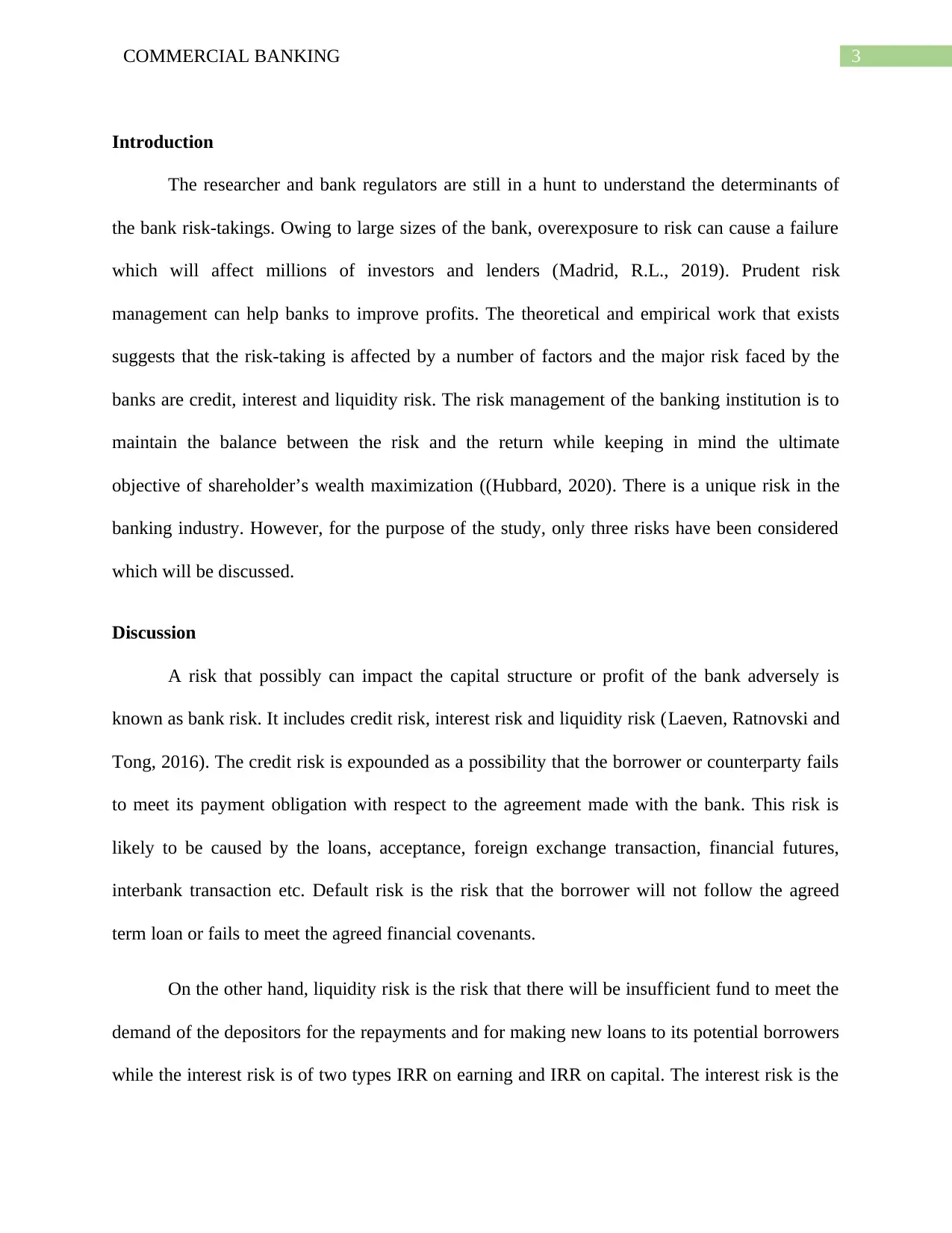
3COMMERCIAL BANKING
Introduction
The researcher and bank regulators are still in a hunt to understand the determinants of
the bank risk-takings. Owing to large sizes of the bank, overexposure to risk can cause a failure
which will affect millions of investors and lenders (Madrid, R.L., 2019). Prudent risk
management can help banks to improve profits. The theoretical and empirical work that exists
suggests that the risk-taking is affected by a number of factors and the major risk faced by the
banks are credit, interest and liquidity risk. The risk management of the banking institution is to
maintain the balance between the risk and the return while keeping in mind the ultimate
objective of shareholder’s wealth maximization ((Hubbard, 2020). There is a unique risk in the
banking industry. However, for the purpose of the study, only three risks have been considered
which will be discussed.
Discussion
A risk that possibly can impact the capital structure or profit of the bank adversely is
known as bank risk. It includes credit risk, interest risk and liquidity risk (Laeven, Ratnovski and
Tong, 2016). The credit risk is expounded as a possibility that the borrower or counterparty fails
to meet its payment obligation with respect to the agreement made with the bank. This risk is
likely to be caused by the loans, acceptance, foreign exchange transaction, financial futures,
interbank transaction etc. Default risk is the risk that the borrower will not follow the agreed
term loan or fails to meet the agreed financial covenants.
On the other hand, liquidity risk is the risk that there will be insufficient fund to meet the
demand of the depositors for the repayments and for making new loans to its potential borrowers
while the interest risk is of two types IRR on earning and IRR on capital. The interest risk is the
Introduction
The researcher and bank regulators are still in a hunt to understand the determinants of
the bank risk-takings. Owing to large sizes of the bank, overexposure to risk can cause a failure
which will affect millions of investors and lenders (Madrid, R.L., 2019). Prudent risk
management can help banks to improve profits. The theoretical and empirical work that exists
suggests that the risk-taking is affected by a number of factors and the major risk faced by the
banks are credit, interest and liquidity risk. The risk management of the banking institution is to
maintain the balance between the risk and the return while keeping in mind the ultimate
objective of shareholder’s wealth maximization ((Hubbard, 2020). There is a unique risk in the
banking industry. However, for the purpose of the study, only three risks have been considered
which will be discussed.
Discussion
A risk that possibly can impact the capital structure or profit of the bank adversely is
known as bank risk. It includes credit risk, interest risk and liquidity risk (Laeven, Ratnovski and
Tong, 2016). The credit risk is expounded as a possibility that the borrower or counterparty fails
to meet its payment obligation with respect to the agreement made with the bank. This risk is
likely to be caused by the loans, acceptance, foreign exchange transaction, financial futures,
interbank transaction etc. Default risk is the risk that the borrower will not follow the agreed
term loan or fails to meet the agreed financial covenants.
On the other hand, liquidity risk is the risk that there will be insufficient fund to meet the
demand of the depositors for the repayments and for making new loans to its potential borrowers
while the interest risk is of two types IRR on earning and IRR on capital. The interest risk is the
Paraphrase This Document
Need a fresh take? Get an instant paraphrase of this document with our AI Paraphraser
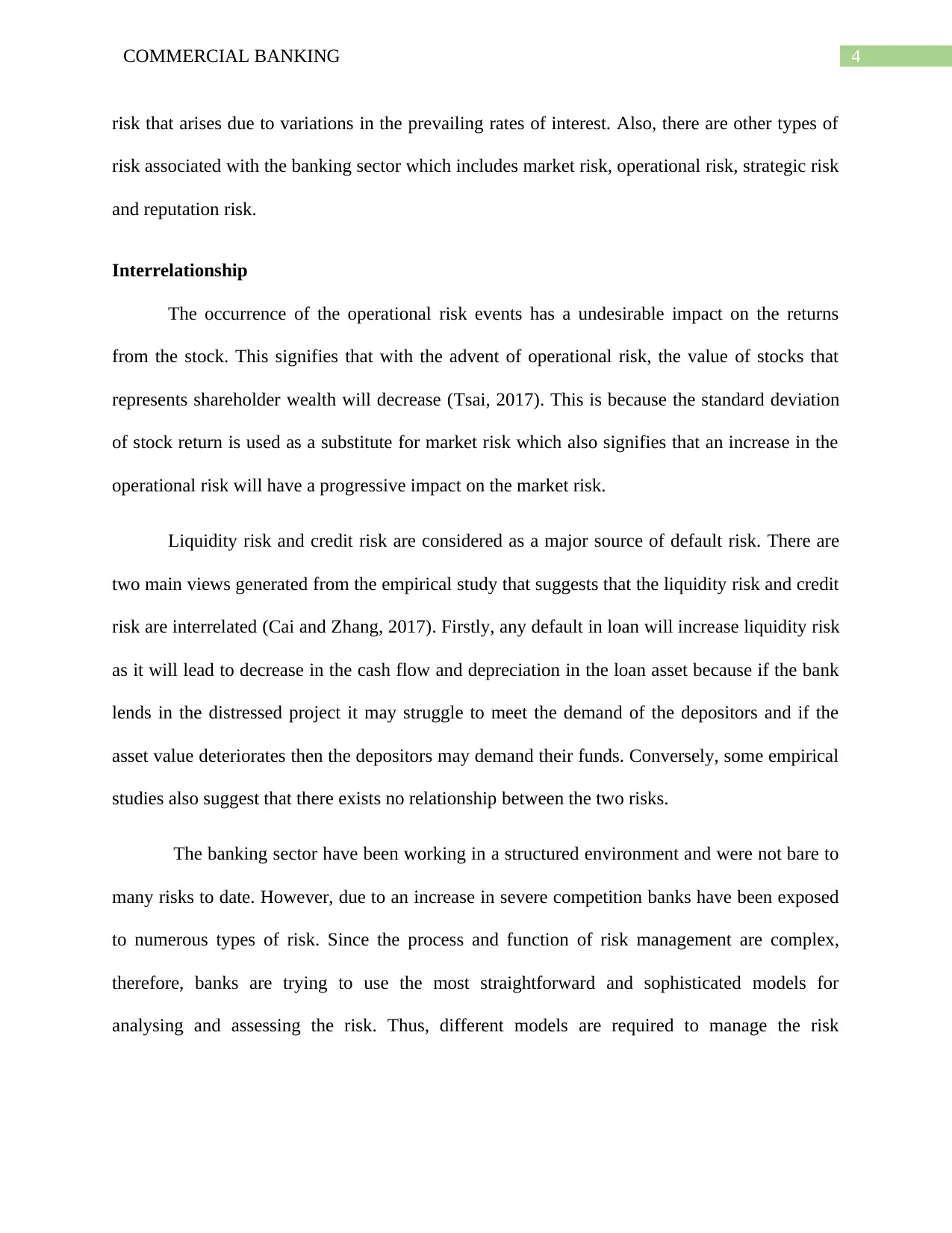
4COMMERCIAL BANKING
risk that arises due to variations in the prevailing rates of interest. Also, there are other types of
risk associated with the banking sector which includes market risk, operational risk, strategic risk
and reputation risk.
Interrelationship
The occurrence of the operational risk events has a undesirable impact on the returns
from the stock. This signifies that with the advent of operational risk, the value of stocks that
represents shareholder wealth will decrease (Tsai, 2017). This is because the standard deviation
of stock return is used as a substitute for market risk which also signifies that an increase in the
operational risk will have a progressive impact on the market risk.
Liquidity risk and credit risk are considered as a major source of default risk. There are
two main views generated from the empirical study that suggests that the liquidity risk and credit
risk are interrelated (Cai and Zhang, 2017). Firstly, any default in loan will increase liquidity risk
as it will lead to decrease in the cash flow and depreciation in the loan asset because if the bank
lends in the distressed project it may struggle to meet the demand of the depositors and if the
asset value deteriorates then the depositors may demand their funds. Conversely, some empirical
studies also suggest that there exists no relationship between the two risks.
The banking sector have been working in a structured environment and were not bare to
many risks to date. However, due to an increase in severe competition banks have been exposed
to numerous types of risk. Since the process and function of risk management are complex,
therefore, banks are trying to use the most straightforward and sophisticated models for
analysing and assessing the risk. Thus, different models are required to manage the risk
risk that arises due to variations in the prevailing rates of interest. Also, there are other types of
risk associated with the banking sector which includes market risk, operational risk, strategic risk
and reputation risk.
Interrelationship
The occurrence of the operational risk events has a undesirable impact on the returns
from the stock. This signifies that with the advent of operational risk, the value of stocks that
represents shareholder wealth will decrease (Tsai, 2017). This is because the standard deviation
of stock return is used as a substitute for market risk which also signifies that an increase in the
operational risk will have a progressive impact on the market risk.
Liquidity risk and credit risk are considered as a major source of default risk. There are
two main views generated from the empirical study that suggests that the liquidity risk and credit
risk are interrelated (Cai and Zhang, 2017). Firstly, any default in loan will increase liquidity risk
as it will lead to decrease in the cash flow and depreciation in the loan asset because if the bank
lends in the distressed project it may struggle to meet the demand of the depositors and if the
asset value deteriorates then the depositors may demand their funds. Conversely, some empirical
studies also suggest that there exists no relationship between the two risks.
The banking sector have been working in a structured environment and were not bare to
many risks to date. However, due to an increase in severe competition banks have been exposed
to numerous types of risk. Since the process and function of risk management are complex,
therefore, banks are trying to use the most straightforward and sophisticated models for
analysing and assessing the risk. Thus, different models are required to manage the risk
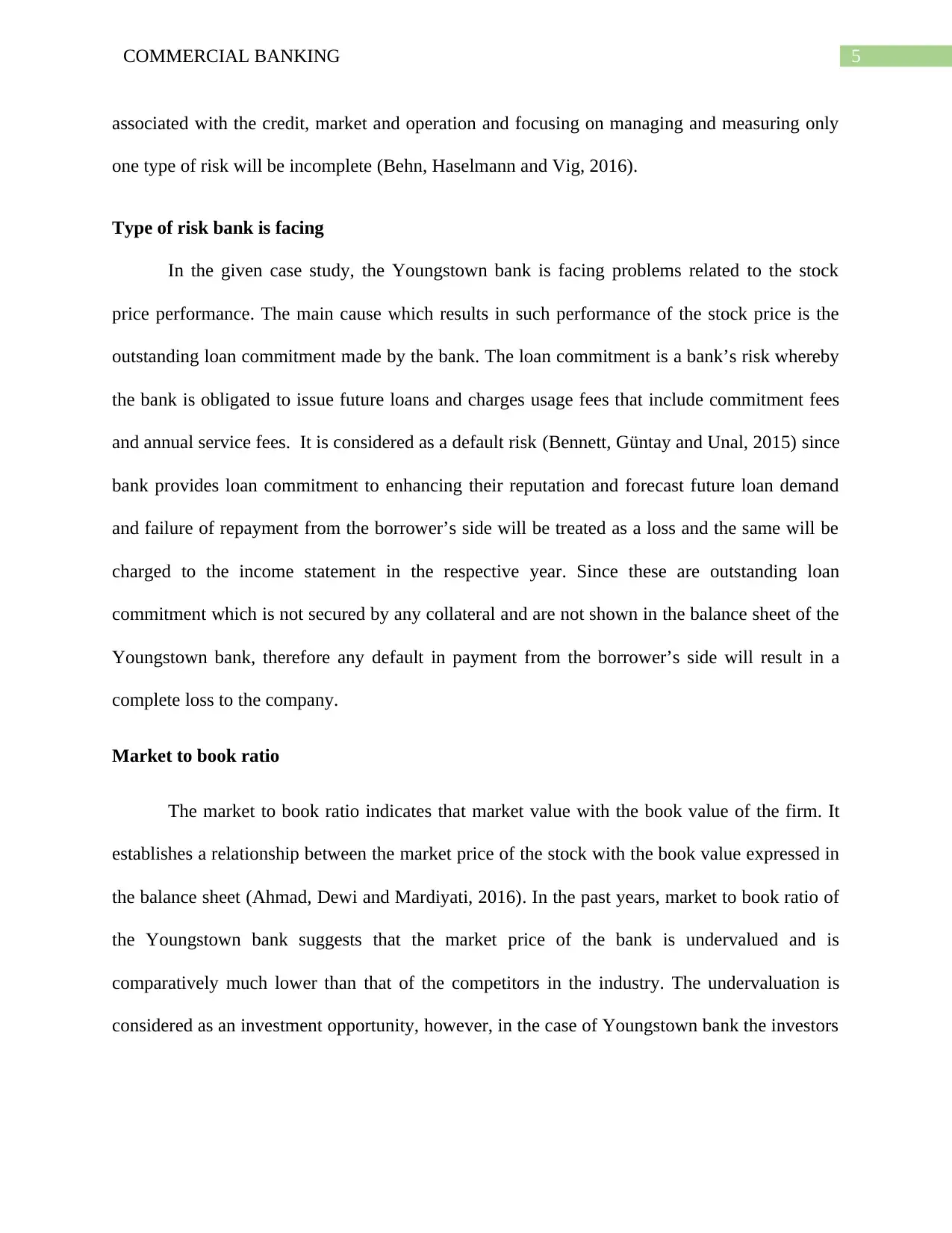
5COMMERCIAL BANKING
associated with the credit, market and operation and focusing on managing and measuring only
one type of risk will be incomplete (Behn, Haselmann and Vig, 2016).
Type of risk bank is facing
In the given case study, the Youngstown bank is facing problems related to the stock
price performance. The main cause which results in such performance of the stock price is the
outstanding loan commitment made by the bank. The loan commitment is a bank’s risk whereby
the bank is obligated to issue future loans and charges usage fees that include commitment fees
and annual service fees. It is considered as a default risk (Bennett, Güntay and Unal, 2015) since
bank provides loan commitment to enhancing their reputation and forecast future loan demand
and failure of repayment from the borrower’s side will be treated as a loss and the same will be
charged to the income statement in the respective year. Since these are outstanding loan
commitment which is not secured by any collateral and are not shown in the balance sheet of the
Youngstown bank, therefore any default in payment from the borrower’s side will result in a
complete loss to the company.
Market to book ratio
The market to book ratio indicates that market value with the book value of the firm. It
establishes a relationship between the market price of the stock with the book value expressed in
the balance sheet (Ahmad, Dewi and Mardiyati, 2016). In the past years, market to book ratio of
the Youngstown bank suggests that the market price of the bank is undervalued and is
comparatively much lower than that of the competitors in the industry. The undervaluation is
considered as an investment opportunity, however, in the case of Youngstown bank the investors
associated with the credit, market and operation and focusing on managing and measuring only
one type of risk will be incomplete (Behn, Haselmann and Vig, 2016).
Type of risk bank is facing
In the given case study, the Youngstown bank is facing problems related to the stock
price performance. The main cause which results in such performance of the stock price is the
outstanding loan commitment made by the bank. The loan commitment is a bank’s risk whereby
the bank is obligated to issue future loans and charges usage fees that include commitment fees
and annual service fees. It is considered as a default risk (Bennett, Güntay and Unal, 2015) since
bank provides loan commitment to enhancing their reputation and forecast future loan demand
and failure of repayment from the borrower’s side will be treated as a loss and the same will be
charged to the income statement in the respective year. Since these are outstanding loan
commitment which is not secured by any collateral and are not shown in the balance sheet of the
Youngstown bank, therefore any default in payment from the borrower’s side will result in a
complete loss to the company.
Market to book ratio
The market to book ratio indicates that market value with the book value of the firm. It
establishes a relationship between the market price of the stock with the book value expressed in
the balance sheet (Ahmad, Dewi and Mardiyati, 2016). In the past years, market to book ratio of
the Youngstown bank suggests that the market price of the bank is undervalued and is
comparatively much lower than that of the competitors in the industry. The undervaluation is
considered as an investment opportunity, however, in the case of Youngstown bank the investors
⊘ This is a preview!⊘
Do you want full access?
Subscribe today to unlock all pages.

Trusted by 1+ million students worldwide
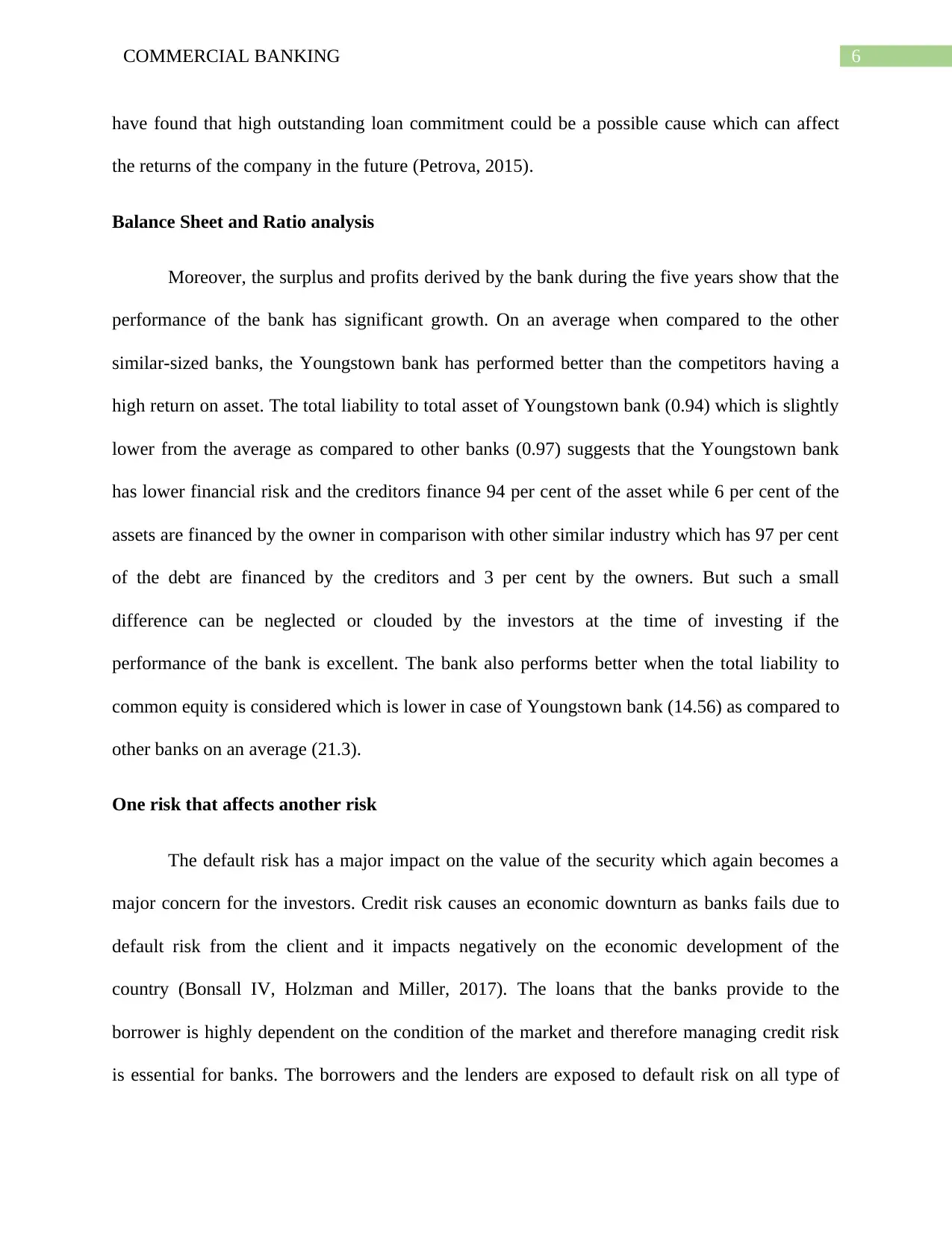
6COMMERCIAL BANKING
have found that high outstanding loan commitment could be a possible cause which can affect
the returns of the company in the future (Petrova, 2015).
Balance Sheet and Ratio analysis
Moreover, the surplus and profits derived by the bank during the five years show that the
performance of the bank has significant growth. On an average when compared to the other
similar-sized banks, the Youngstown bank has performed better than the competitors having a
high return on asset. The total liability to total asset of Youngstown bank (0.94) which is slightly
lower from the average as compared to other banks (0.97) suggests that the Youngstown bank
has lower financial risk and the creditors finance 94 per cent of the asset while 6 per cent of the
assets are financed by the owner in comparison with other similar industry which has 97 per cent
of the debt are financed by the creditors and 3 per cent by the owners. But such a small
difference can be neglected or clouded by the investors at the time of investing if the
performance of the bank is excellent. The bank also performs better when the total liability to
common equity is considered which is lower in case of Youngstown bank (14.56) as compared to
other banks on an average (21.3).
One risk that affects another risk
The default risk has a major impact on the value of the security which again becomes a
major concern for the investors. Credit risk causes an economic downturn as banks fails due to
default risk from the client and it impacts negatively on the economic development of the
country (Bonsall IV, Holzman and Miller, 2017). The loans that the banks provide to the
borrower is highly dependent on the condition of the market and therefore managing credit risk
is essential for banks. The borrowers and the lenders are exposed to default risk on all type of
have found that high outstanding loan commitment could be a possible cause which can affect
the returns of the company in the future (Petrova, 2015).
Balance Sheet and Ratio analysis
Moreover, the surplus and profits derived by the bank during the five years show that the
performance of the bank has significant growth. On an average when compared to the other
similar-sized banks, the Youngstown bank has performed better than the competitors having a
high return on asset. The total liability to total asset of Youngstown bank (0.94) which is slightly
lower from the average as compared to other banks (0.97) suggests that the Youngstown bank
has lower financial risk and the creditors finance 94 per cent of the asset while 6 per cent of the
assets are financed by the owner in comparison with other similar industry which has 97 per cent
of the debt are financed by the creditors and 3 per cent by the owners. But such a small
difference can be neglected or clouded by the investors at the time of investing if the
performance of the bank is excellent. The bank also performs better when the total liability to
common equity is considered which is lower in case of Youngstown bank (14.56) as compared to
other banks on an average (21.3).
One risk that affects another risk
The default risk has a major impact on the value of the security which again becomes a
major concern for the investors. Credit risk causes an economic downturn as banks fails due to
default risk from the client and it impacts negatively on the economic development of the
country (Bonsall IV, Holzman and Miller, 2017). The loans that the banks provide to the
borrower is highly dependent on the condition of the market and therefore managing credit risk
is essential for banks. The borrowers and the lenders are exposed to default risk on all type of
Paraphrase This Document
Need a fresh take? Get an instant paraphrase of this document with our AI Paraphraser

7COMMERCIAL BANKING
credit extension. A higher degree of risk will lead to a higher required return and subsequently, a
higher rate of interest (Engel, 2016). The associated risk with the high-interest rates causes the
price of the bond to fall since interest rates and bonds prices are related inversely.
Recommendation
The public debt has been increased in advanced economics recently and has raised the
spectra of sovereign default and regenerated the debate regarding coordination problems. The
company has to reduce its loan commitment in the future years since it has already increased
more than 300 per cent in 2004 as compared to the year 2000. By restricting the outstanding loan
commitment, the bank can regenerate the faith of the investors and which can impact the stock
price of the Youngstown bank positively (Black and Rosen, 2016).
Conclusion
In a nutshell, every bank has a different risk relationship with other banks and similarly,
every bank has a different relationship between liquidity, interest, credit and market risk. The
banks have different mitigation tools with different benchmarks still the Youngstown bank does
not have sufficient asset to cover the risk of outstanding loan commitment which can result to
default risk if there is economic adversity or situation of economic crisis. The chief executive
officer and chief financial officer have overlooked this outstanding loan commitment and due to
which the investors hesitate to invest and as a result, there is no fluctuation in the share price of
the Youngstown bank.
credit extension. A higher degree of risk will lead to a higher required return and subsequently, a
higher rate of interest (Engel, 2016). The associated risk with the high-interest rates causes the
price of the bond to fall since interest rates and bonds prices are related inversely.
Recommendation
The public debt has been increased in advanced economics recently and has raised the
spectra of sovereign default and regenerated the debate regarding coordination problems. The
company has to reduce its loan commitment in the future years since it has already increased
more than 300 per cent in 2004 as compared to the year 2000. By restricting the outstanding loan
commitment, the bank can regenerate the faith of the investors and which can impact the stock
price of the Youngstown bank positively (Black and Rosen, 2016).
Conclusion
In a nutshell, every bank has a different risk relationship with other banks and similarly,
every bank has a different relationship between liquidity, interest, credit and market risk. The
banks have different mitigation tools with different benchmarks still the Youngstown bank does
not have sufficient asset to cover the risk of outstanding loan commitment which can result to
default risk if there is economic adversity or situation of economic crisis. The chief executive
officer and chief financial officer have overlooked this outstanding loan commitment and due to
which the investors hesitate to invest and as a result, there is no fluctuation in the share price of
the Youngstown bank.
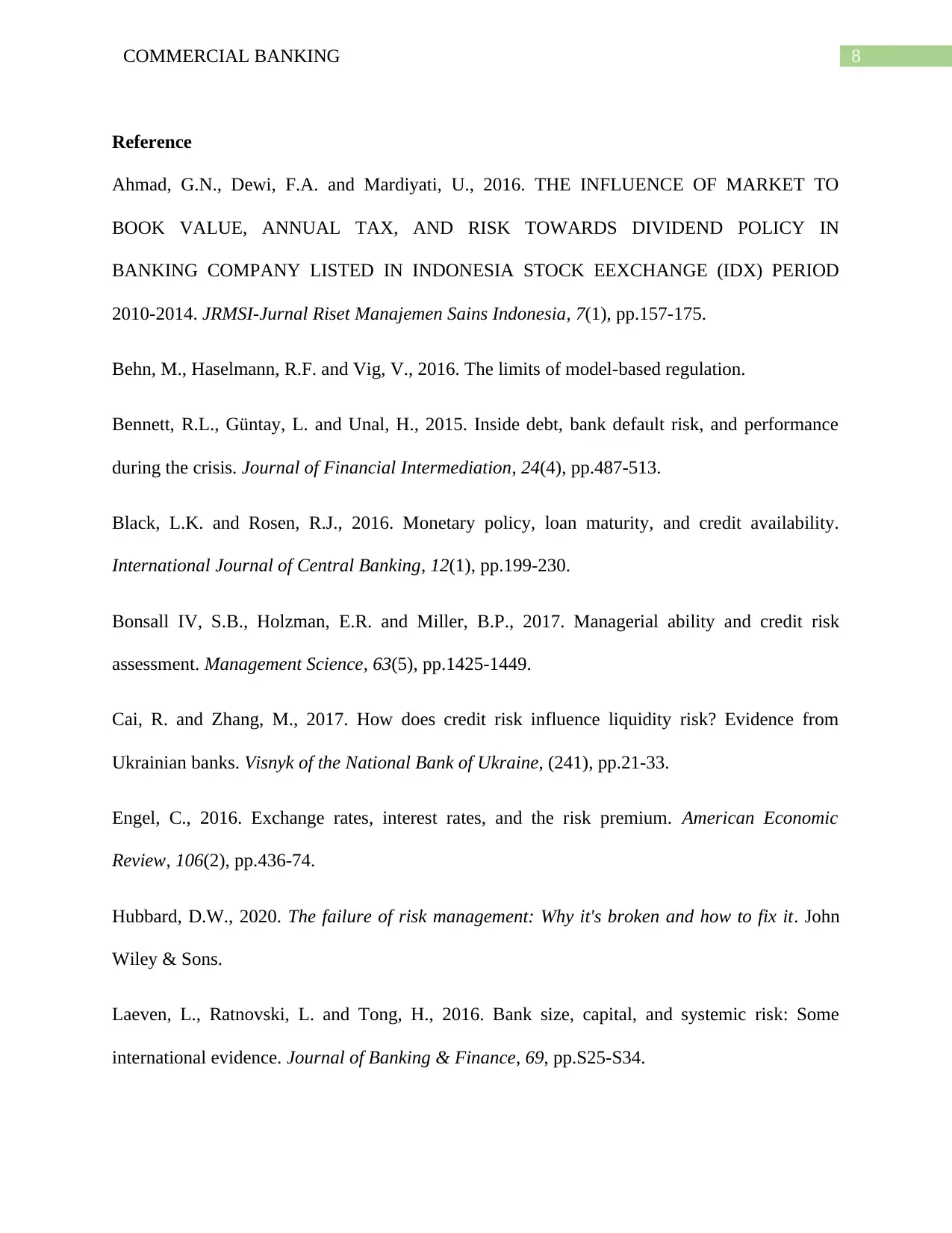
8COMMERCIAL BANKING
Reference
Ahmad, G.N., Dewi, F.A. and Mardiyati, U., 2016. THE INFLUENCE OF MARKET TO
BOOK VALUE, ANNUAL TAX, AND RISK TOWARDS DIVIDEND POLICY IN
BANKING COMPANY LISTED IN INDONESIA STOCK EEXCHANGE (IDX) PERIOD
2010-2014. JRMSI-Jurnal Riset Manajemen Sains Indonesia, 7(1), pp.157-175.
Behn, M., Haselmann, R.F. and Vig, V., 2016. The limits of model-based regulation.
Bennett, R.L., Güntay, L. and Unal, H., 2015. Inside debt, bank default risk, and performance
during the crisis. Journal of Financial Intermediation, 24(4), pp.487-513.
Black, L.K. and Rosen, R.J., 2016. Monetary policy, loan maturity, and credit availability.
International Journal of Central Banking, 12(1), pp.199-230.
Bonsall IV, S.B., Holzman, E.R. and Miller, B.P., 2017. Managerial ability and credit risk
assessment. Management Science, 63(5), pp.1425-1449.
Cai, R. and Zhang, M., 2017. How does credit risk influence liquidity risk? Evidence from
Ukrainian banks. Visnyk of the National Bank of Ukraine, (241), pp.21-33.
Engel, C., 2016. Exchange rates, interest rates, and the risk premium. American Economic
Review, 106(2), pp.436-74.
Hubbard, D.W., 2020. The failure of risk management: Why it's broken and how to fix it. John
Wiley & Sons.
Laeven, L., Ratnovski, L. and Tong, H., 2016. Bank size, capital, and systemic risk: Some
international evidence. Journal of Banking & Finance, 69, pp.S25-S34.
Reference
Ahmad, G.N., Dewi, F.A. and Mardiyati, U., 2016. THE INFLUENCE OF MARKET TO
BOOK VALUE, ANNUAL TAX, AND RISK TOWARDS DIVIDEND POLICY IN
BANKING COMPANY LISTED IN INDONESIA STOCK EEXCHANGE (IDX) PERIOD
2010-2014. JRMSI-Jurnal Riset Manajemen Sains Indonesia, 7(1), pp.157-175.
Behn, M., Haselmann, R.F. and Vig, V., 2016. The limits of model-based regulation.
Bennett, R.L., Güntay, L. and Unal, H., 2015. Inside debt, bank default risk, and performance
during the crisis. Journal of Financial Intermediation, 24(4), pp.487-513.
Black, L.K. and Rosen, R.J., 2016. Monetary policy, loan maturity, and credit availability.
International Journal of Central Banking, 12(1), pp.199-230.
Bonsall IV, S.B., Holzman, E.R. and Miller, B.P., 2017. Managerial ability and credit risk
assessment. Management Science, 63(5), pp.1425-1449.
Cai, R. and Zhang, M., 2017. How does credit risk influence liquidity risk? Evidence from
Ukrainian banks. Visnyk of the National Bank of Ukraine, (241), pp.21-33.
Engel, C., 2016. Exchange rates, interest rates, and the risk premium. American Economic
Review, 106(2), pp.436-74.
Hubbard, D.W., 2020. The failure of risk management: Why it's broken and how to fix it. John
Wiley & Sons.
Laeven, L., Ratnovski, L. and Tong, H., 2016. Bank size, capital, and systemic risk: Some
international evidence. Journal of Banking & Finance, 69, pp.S25-S34.
⊘ This is a preview!⊘
Do you want full access?
Subscribe today to unlock all pages.

Trusted by 1+ million students worldwide

9COMMERCIAL BANKING
Madrid, R.L., 2019. Overexposed: US Banks Confront the Third World Debt Crisis. Routledge.
Tsai, I.C., 2017. The source of global stock market risk: A viewpoint of economic policy
uncertainty. Economic Modelling, 60, pp.122-131.
Petrova, E., 2015, June. Value investing-essence and ways of finding undervalued assets. In
International conference KNOWLEDGE-BASED ORGANIZATION (Vol. 21, No. 2, pp. 344-
348). De Gruyter Open.
Madrid, R.L., 2019. Overexposed: US Banks Confront the Third World Debt Crisis. Routledge.
Tsai, I.C., 2017. The source of global stock market risk: A viewpoint of economic policy
uncertainty. Economic Modelling, 60, pp.122-131.
Petrova, E., 2015, June. Value investing-essence and ways of finding undervalued assets. In
International conference KNOWLEDGE-BASED ORGANIZATION (Vol. 21, No. 2, pp. 344-
348). De Gruyter Open.
1 out of 10
Related Documents
Your All-in-One AI-Powered Toolkit for Academic Success.
+13062052269
info@desklib.com
Available 24*7 on WhatsApp / Email
![[object Object]](/_next/static/media/star-bottom.7253800d.svg)
Unlock your academic potential
Copyright © 2020–2025 A2Z Services. All Rights Reserved. Developed and managed by ZUCOL.





